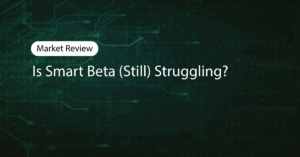Is Smart Beta (Still) Struggling?Market Review | October 2025
Introduction
Several widely recognized risk factors have failed to deliver a performance premium during recent years. Yet how have factor-based equity strategies such as rules-based ‘smart beta,’ ‘enhanced beta’ and highly systematic active funds actually performed in this climate? The sector has become increasingly diverse and complex, with the rise of multi-factor as well as single-factor strategies and promises of greater sophistication on subjects such as risk control and factor timing. In this Market Review, we look at the performance of a broad universe of ‘smart beta’ and ‘style’ funds over the past three years and ask: what has set winners apart?
Key takeaways
- Most ‘smart beta’ and ‘style’ funds have underperformed market cap-weighted benchmarks (U.S. and Europe ) over the three years to August 31st, 2025. U.S. strategies lag the market by more than 5% per year net of fees , while European strategies did rather better, falling behind the benchmark by just over 1% per year.
- Long-beta positioning was the main driver of U.S. strategy outperformance. The strongest results were generated by funds that were—on average—quite close to the benchmark in terms of average factor exposures and took less active risk. Bottom-quintile U.S. funds, on average, have a more distinct ‘style’ profile with tilts toward Value, Low Volatility and—of course—Size.
- In Europe, idiosyncratic risk was the key driver of both active risk and outperformance. Top-tercile managers typically had positive exposure to struggling factors as well as low-beta positioning but outperformed the market-cap benchmark in spite of those detractors. Idiosyncratic risk was also a notable positive contributor for the U.S. top quintile.
While not exhaustive, these findings point to a need for scrutiny. Many global asset owners have sought to reduce carbon emissions and/or improve various climate alignment metrics in public equity portfolios during the decade that has followed the Paris Climate Change Conference. While outperformance may not be among an investor’s objectives, stakeholder support has historically been strengthened by evidence suggesting that relative losses (if any) would likely be minimal. Deeper insight can help investors to assess portfolios and consider whether adjustments may be appropriate.
View performance and risk data for your equity portfolio and compare it to a wide range of equity strategies on the Scientific Portfolio platform.
Authors
Matteo Bagnara, PhD
Quant Researcher,
Scientific Portfolio ……………………………………….
Deputy CEO and Business Development Director,
Scientific Portfolio
Read the full Market Review
"*" indicates required fields


